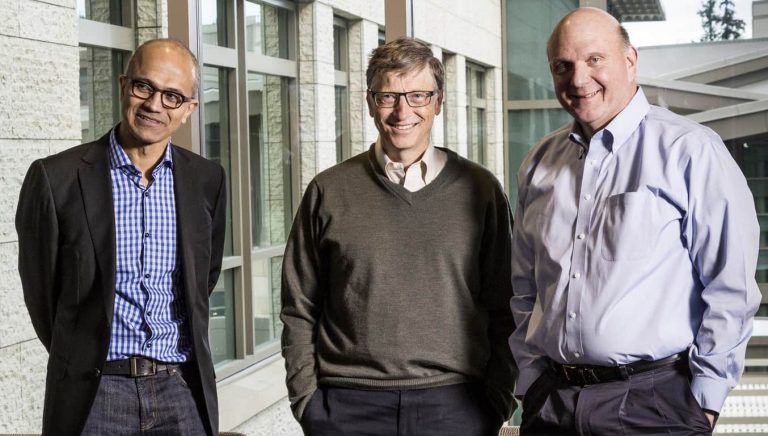Despite having been replaced by Satya Nadella as Microsoft’s CEO over two years ago, Steve Ballmer is still a great influence on the company where he led for 14 years. Judging from the company stocks he still has in his possession, that influence is likely not going away any time soon. In this important year for Microsoft, Business Insider has managed to catch up with Ballmer for an interview in which he reveals his thoughts about Microsoft’s performance, future prospects, and its ailing mobile phone business, among other personal tidbits.
Steve Ballmer attended Harvard alongside Microsoft founder Bill Gates, and later dropped out of Stanford to join Microsoft in 1980 as its 30th employee. Ballmer had been at the company ever since, all the way up to 2013 when he resigned – a staggering 33-year career, along which he has been named President of Microsoft, second only to Bill Gates, before eventually replacing him as the second CEO of the company. His early involvement and exceptionally long time with Redmond explains his burning passion for the company, often visible at Microsoft events and in internet memes. It also gives him an intimate knowledge of his former workplace’s business history and a venerable body of experience.
There are things that can be more easily recognized, however, from an “outsider” perspective to the company – a position that Ballmer continue to stress regarding his relationship with Microsoft, as he is no longer on the Microsoft board. Thinking as an investor instead of from inside the company has given him a new vantage point to see Microsoft’s business and the freedom to share it without the urge to hold management accountable. In fact, Ballmer admits to seeing Microsoft’s CFO every quarter, meeting with Nadella a few times a year, and having casual chats with many of its former colleagues.
“When you take a look at the transition from server software to Azure, what’s going on in terms of cloud infrastructure, the company is absolutely the No. 1 company serving enterprise backbone needs, which is fantastic. It’s making the migration to cloud. We started a good thing with Azure, and the company has made well more than two years of progress in terms of being able to compete with the right cost profile, margin structure, and innovation versus Amazon.”
Not like the company is on a negative stretch, of course: one of the things Ballmer remarked on was how well Microsoft is doing in cloud infrastructure and cloud-based services. The transition to Office 365 from traditional model was started under Ballmer, and has seen great results so far. The same thing can be said about Azure, Microsoft’s cloud infrastructure brand, which went from relatively new to number 2 in cloud providers and competing head-to-head with Amazon Web Services (AWS); there is still work to be done in terms of evangelizing it to the startup community, according to Ballmer from his personal experience.
“..innovation in the future will either be from the cloud out to all devices, or from devices as supported by software in the cloud. I think it’s important for Microsoft to participate both ways.”
Ballmer also remarked on Microsoft’s positive result with leveraging its cloud potential in new devices and innovation, most notably the Surface device line, HoloLens and the Xbox. These devices are closely connected to Microsoft’s cloud, and in turn bring the cloud’s power to users, the best example of which is the Surface. The market has certainly seen the benefit: Surface turned into a profittable billion-dollar business just last year.
Of course, with such extensive talk about Microsoft’s cloud business, it’s hard not to mention current CEO Satya Nadella, who has led the cloud effort at Redmond for a long time before assuming total command. Satya has championed Microsoft’s new positioning in the “mobile-first, cloud-first world” and done a great job in driving the company in new ways, something Ballmer admits to not being able to do.
“Because if you’re going to be mobile-first, cloud-first you really do need to have a sense of what you’re doing in mobile devices.”
Of course there are still things to be improved for Microsoft, the biggest problem of whom has to be in mobile devices. By making the decision of buying Nokia along with the board just before he left his post, Ballmer has put Microsoft on a clear path to mobile devices, a path from which Satya Nadella has clearly diverged with new cross-platform strategies, lack of device, and paltry marketshare reports. Now Microsoft needs to find a “clear path forward” for mobile, something Ballmer trusts Nadella would be able to pull off.
Steve Ballmer at the Oxford Union last year.
Besides a comprehensive view on Microsoft’s businesses, Ballmer also shares many other interesting things about his current life, work as owner of the Los Angeles Clippers and philanthropy project, his investment in Twitter, basketball analytics and guilty pleasures – or in Ballmer words, ways for him to “spoil himself” – all of which can be found in the source article.
Overall, despite no longer at the head of Microsoft, Ballmer is still just as passionate about the company, and his experience leading the company will continue to help it grow even more in the years to come.


